Increased focus on deficit reduction; Republicans far more likely than Democrats to view it as a top priority
Pew Research Center conducted this study to understand which issues the public views as most important for the president and Congress to prioritize in the coming year. For this analysis, we surveyed 5,152 adults from Jan. 18-24, 2023. Everyone who took part in this survey is a member of the Center’s American Trends Panel (ATP), an online survey panel that is recruited through national, random sampling of residential addresses. This way nearly all U.S. adults have a chance of selection. The survey is weighted to be representative of the U.S. adult population by gender, race, ethnicity, partisan affiliation, education and other categories. Read more about the ATP’s methodology.
Here are the questions used for the report and its methodology.
With a new era of divided government beginning in Washington, the public’s top policy priority has not changed: Strengthening the economy tops Americans’ agenda, as it did a year ago.
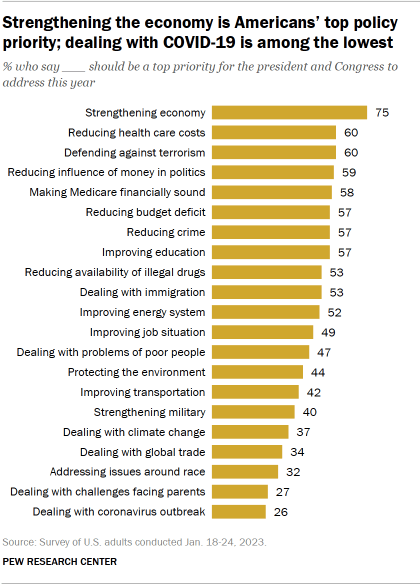
However, there have been some notable changes in Americans’ priorities for the president and Congress to address this year. Reducing the budget deficit is now a higher priority for the public than in recent years (now 57% vs. 45% a year ago). The change has come among members of both parties, though Republicans and those who lean to the Republican Party (71%) are far more likely than Democrats and Democratic leaners (44%) to view cutting the deficit as a leading priority. And dealing with the coronavirus outbreak is now one of the lowest priorities for Americans – just 26% now say it should be a top priority for the president and Congress, but it was among the top priorities in both 2021 and 2022.
Overall, 75% of Americans say strengthening the economy should be a top priority this year, according to a new Pew Research Center survey conducted Jan. 18-24, 2023, among 5,152 U.S. adults. The public continues to express negative views of national economic conditions, despite continued job growth and signs that inflation may be easing. Just 21% rate economic conditions as excellent or good, which is only a slight increase from October (17%).
Aside from the economy, no single policy area stands out. About six-in-ten rate several issues as top priorities: reducing health care costs (60%), defending against terrorism (60%), reducing the influence of money in politics (59%), reducing the budget deficit (57%), reducing crime (57%) and improving education (57%).
About half of Americans (53%) say reducing the availability of illegal drugs, including heroin, fentanyl and cocaine, should be a top priority for the president and Congress. Similar shares say the same about dealing with immigration (53%), improving the energy system (52%) and improving the job situation (49%).
Among the lowest items on the public’s agenda for the president and Congress are dealing with climate change (37%), dealing with global trade issues (34%) and addressing issues around race (32%). The public gives the lowest priority to dealing with the challenges facing parents (27%) and dealing with the coronavirus outbreak (26%). (For a closer look at the top policy priorities of partisan and demographic groups, see the detailed tables accompanying this report.)
While there are sizable differences in the shares of Americans who rate each of the 21 items included in the survey as a “top priority” for the president and Congress to address this year, in most cases large majorities rate each one as either a top priority or as an “important but lower priority.” Relatively few Americans say these policies “should not be done” or are “not too important.” At most, about 10% say a handful of policies should not be done (including 11% who say this about dealing with climate change and 9% for dealing with the coronavirus outbreak).
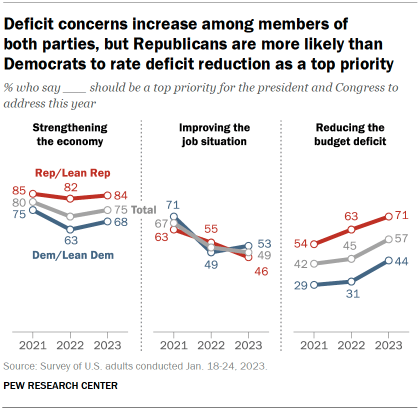
Strengthening the economy has long been among the public’s top policy priorities. As has been the case for the last several years, strengthening the economy is a higher priority among Republicans and independents who lean Republican (84% say top priority) than among Democrats and Democratic leaners (68%).
Republicans (71%) also are much more likely than Democrats (44%) to say reducing the budget deficit should be a top priority, though both Republicans and Democrats are more likely to say this now than in either of the past two years. The share saying deficit reduction should be a top priority has increased 8 percentage points among Republicans and 13 points among Democrats since last year.
Fewer Americans now say improving the job situation should be a top priority for Congress and the president than said so in 2021. Today, 53% of Democrats and 46% of Republicans say improving the job situation should be a top priority. Last year, Republicans were modestly more likely than Democrats (55% vs. 49%) to name improving the job situation as a top priority.
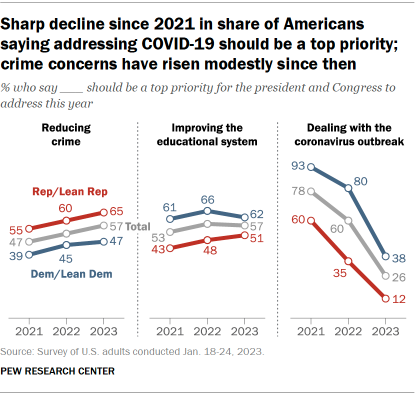
Since 2021, reducing crime and improving education have risen as priorities for the public – especially among Republicans – while dealing with the coronavirus has declined substantially as a policy priority over the same period.
Crime reduction remains a higher priority among Republicans than among Democrats. Yet, compared with two years ago, the shares of both Republicans and Democrats who view it as a top priority have grown. Currently, 65% of Republicans and 47% of Democrats say it should be a top priority.
While a larger share of Democrats (62%) than Republicans (51%) say improving education should be a top federal priority this year, the share of Republicans saying this has increased by 8 percentage points since 2021.
The share of Americans who view dealing with the coronavirus outbreak as a top priority has declined about 50 points since 2021 (from 78% to 26%), including a drop of more than 30 points in the last year. As was the case in previous years, Democrats (38%) are more likely than Republicans (12%) to say dealing with COVID-19 should be a top priority for the president and Congress this year.
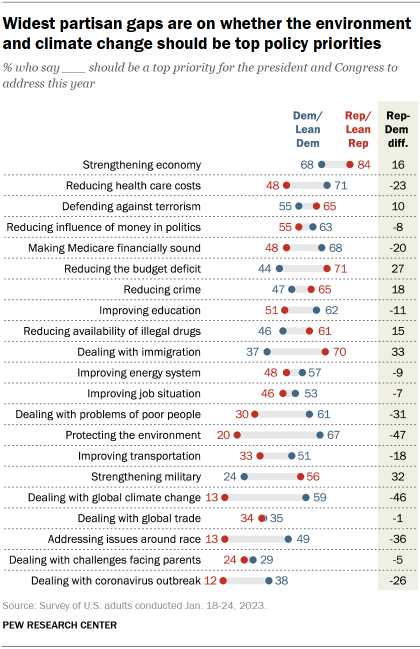
There are wide partisan differences over many of the policy areas included in the survey.
The largest gaps between Republicans and Democrats are on protecting the environment and dealing with global climate change. Two-thirds of Democrats say environmental protection should be a top priority, compared with 20% of Republicans. Similarly, 59% of Democrats say this about climate change versus just 13% of Republicans.
Democrats also are much more likely than Republicans to prioritize addressing issues around race (49% top priority among Democrats vs. 13% among Republicans) and dealing with the problems faced by the poor (61% vs. 30%, respectively).
Conversely, Republicans are more likely than Democrats to rate dealing with immigration (70% among Republicans vs. 37% among Democrats), strengthening the military (56% vs. 24%) and reducing the budget deficit (71% vs. 44%) as top priorities for the president and Congress.
In one area – dealing with global trade – there is no partisan gap in prioritization, though relatively few among either Republicans (34%) or Democrats (35%) rate this as a top priority for the president and Congress. There are also only modest partisan differences in the shares naming dealing with the challenges facing parents (24% among Republicans, 29% among Democrats) and improving the job situation (46% to 53%, respectively).
Policy priorities of Black, Hispanic and White Americans

Strengthening the nation’s economy stands out as a top priority across racial and ethnic groups, with about three-quarters of White (76%), Black (77%) and Hispanic (76%) adults saying it should be a focus for the president and Congress this year. Roughly six-in-ten White, Black and Hispanic adults also say reducing the influence of money in politics (59%, 58% and 58%, respectively) and reducing the budget deficit (58%, 61% and 56%) should be top priorities.
Black adults are more likely than White and Hispanic adults to say that several other issues should be at the top of the agenda this year. About seven-in-ten Black adults (72%) say that addressing issues around race should be a top priority. By comparison, far smaller shares of Hispanic (43%) or White adults (21%) rate this as a top priority.
In addition, 73% of Black adults view dealing with problems associated with poverty as a top priority for the administration and Congress, compared with 58% of Hispanic adults and 38% of White adults.
While dealing with the coronavirus outbreak has declined as a top priority across racial and ethnic groups, Black adults (51%) remain more likely than Hispanic (35%) and White (17%) adults to view dealing with the pandemic as a top priority.

As with the general public, there are significant racial and ethnic differences among Democrats and Democratic-leaning independents across racial and ethnic groups in what they want this year’s national policy agenda to focus on.
For example, 51% of Hispanic Democrats view dealing with immigration as a top priority, compared with 38% of Black Democrats and 32% of White Democrats.
On the issue of reducing crime, Black (66%) and Hispanic (63%) Democrats are roughly twice as likely as White Democrats (33%) to view it as a top priority.
White Democrats (64%) are somewhat more likely than Hispanic (56%) and Black (52%) Democrats to view dealing with global climate change as a top priority this year.
Age and policy priorities
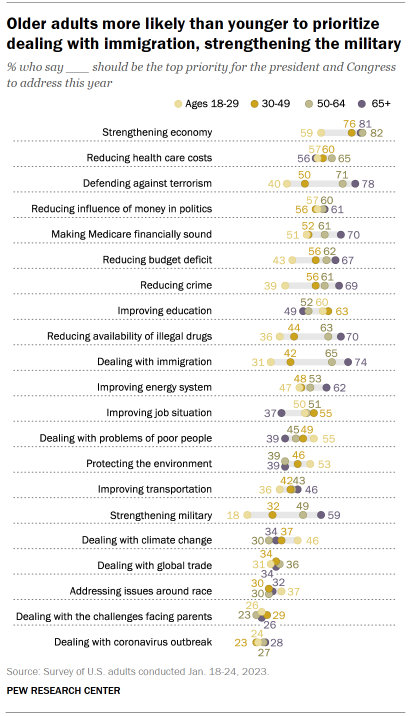
There are a few issues that similar shares of older and younger adults regard as top priorities for the year. For instance, about six-in-ten in all age groups say reducing the influence of money in politics should be a top priority. And, in contrast to last year, there is now little difference across age groups in seeing the coronavirus outbreak as a priority, with no more than three-in-ten in any age group saying this.
In general, older adults prioritize a number of issues significantly more than younger adults.
About seven-in-ten adults ages 50 and older (69%) say that dealing with immigration should be a top priority, compared with about four-in-ten of those under 50 (38%). Similarly, 75% of those 50 and older say defending the country against terrorism should be a top priority, compared with 46% of adults ages 18 to 49.
Older adults are also more likely than younger adults to prioritize several other issues, including strengthening the military, reducing crime and reducing the availability of illegal drugs like heroin, fentanyl and cocaine.
By contrast, adults under age 50 place higher priority on improving the educational system (62% say this is a top priority vs. 50% among those age 50 and older), improving the job situation (54% vs. 44%) and protecting the environment (49% vs. 39%).
Few say policy priorities ‘should not be done’
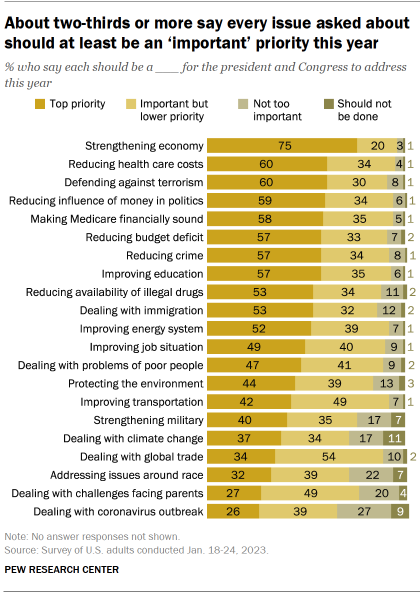
For all 21 priorities asked about on the survey, about two-thirds of Americans or more say each should be a top priority or that it is an important but lower priority.
No more than about one-in-ten Americans say any of these priorities should not be done. Only four policy areas have more than 5% of the public saying they should not be done: dealing with climate change (11%), dealing with the coronavirus outbreak (9%), strengthening the military (7%) and addressing issues around race (7%).
These same areas are the only ones in which one-in-ten or more in a partisan group say they should not be done. About a quarter of Republicans (24%) say dealing with climate change should not be done, while roughly two-in-ten (18%) say the same about dealing with COVID-19; 14% of Republicans say addressing issues around race should not be done by the president and Congress, while a similar share of Democrats (12%) say this about strengthening the military.


